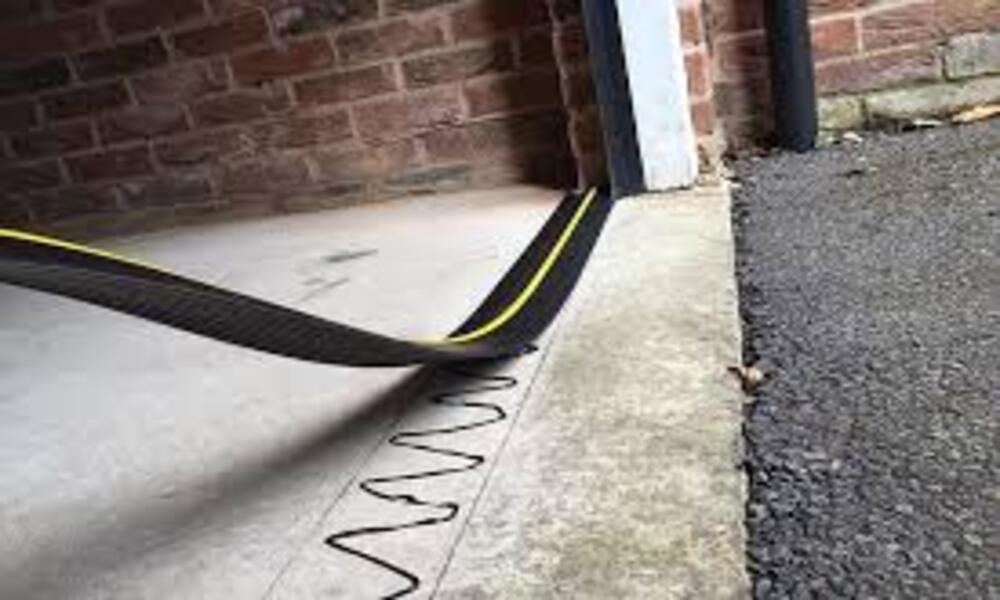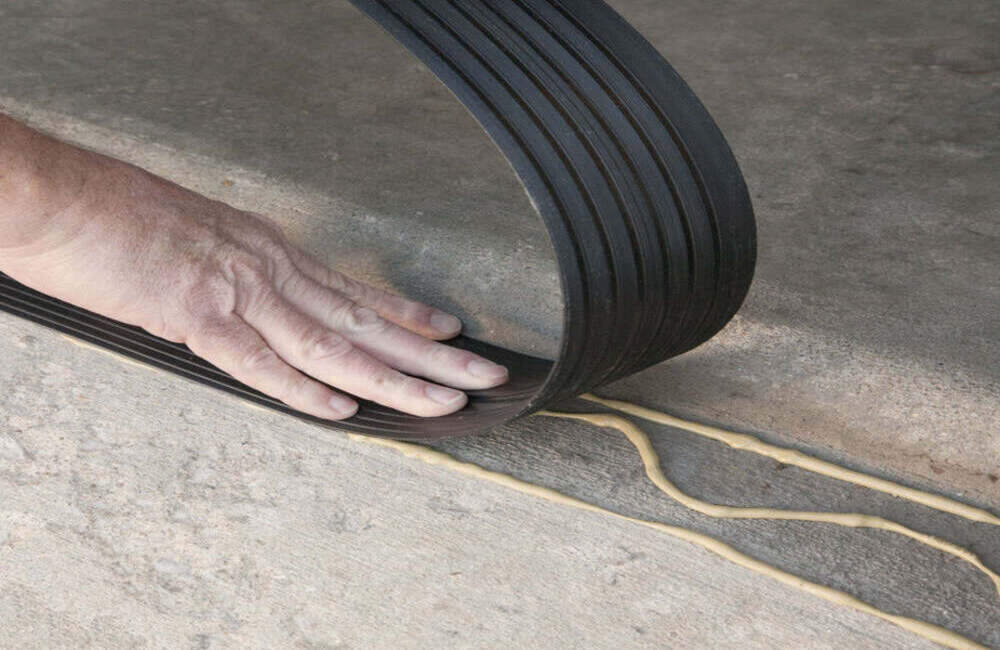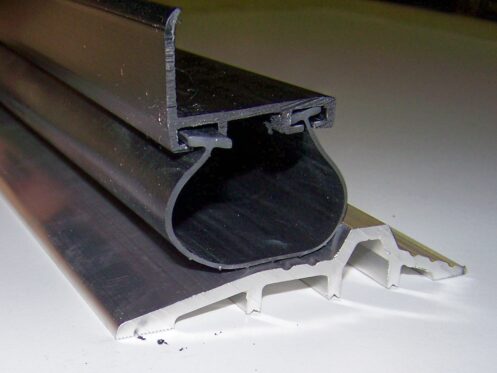When securing a garage door threshold, choosing the right adhesive is crucial for long-lasting performance and a proper seal.
The threshold helps protect your garage from weather, dirt, and pests.
In this article, we’ll explore the best adhesives for garage door thresholds, factors to consider when selecting one, and how to apply it correctly for optimal results.
What’s the best adhesive for attaching a garage door threshold?
A high-strength, weather-resistant adhesive like construction adhesive or a silicone sealant is perfect for bonding garage door thresholds, ensuring a durable and waterproof seal.
Key Takeaways
- The right adhesive ensures that your garage door threshold remains securely in place, preventing drafts and leaks.
- Different adhesives work better for different materials and conditions, so it’s important to choose accordingly.
- Proper surface preparation is essential for achieving a strong bond that lasts.
Understanding Garage Door Thresholds

A garage door threshold is a rubber or vinyl strip placed along the bottom of the garage door to form a seal between the door and the ground. If you’re wondering how to replace a garage door seal, it typically involves removing the old threshold and installing a new one to maintain proper insulation and keep out water, dirt, and pests.
This seal helps to prevent water, dirt, and insects from entering the garage, and it also improves energy efficiency by keeping the inside temperature stable.
A properly installed threshold can help avoid issues such as flooding, cold drafts, and the accumulation of debris inside the garage.
However, securing it properly with the right adhesive is just as important as the threshold material itself.
Types of Adhesives for Garage Door Thresholds
There are various adhesives available for securing a garage door threshold, each designed for different types of materials and conditions.
Below are some of the most effective adhesive options for this job.
1. Construction Adhesive
Construction adhesive is one of the best adhesives for garage door thresholds due to its strong bonding power.
It is designed to adhere to a variety of surfaces, including concrete, metal, wood, and plastic, making it ideal for securing the threshold to the garage floor.
Advantages: Strong bond, versatile, and ideal for outdoor conditions. It can handle extreme temperatures and moisture, which is essential for garage environments.
Application: Apply the adhesive to the back of the threshold strip, press it firmly into place, and allow it to cure according to the manufacturer’s instructions.
2. Silicone Adhesive
Silicone adhesive is another excellent option for securing a garage door threshold, especially if you need a waterproof seal.
It’s highly flexible and can withstand both heat and cold, which makes it perfect for use in a garage that may experience temperature fluctuations.
Advantages: Waterproof, flexible, and resistant to environmental changes. It provides a strong, lasting seal that won’t crack or break.
Application: Clean the surface of the garage door and floor thoroughly. Apply the silicone adhesive along the edge of the threshold and press it into place.
3. Epoxy Adhesive
Epoxy adhesives are known for their high strength and durability. They consist of two components – a resin and a hardener – which, when mixed, form a strong bond.
Epoxy is ideal for situations where the adhesive needs to withstand heavy-duty use and weight.
Advantages: Provides a permanent bond and is incredibly durable. Epoxy is ideal for securing thresholds in high-traffic areas or garages with heavy equipment.
Application: Mix the resin and hardener according to the instructions. Apply the mixture to the threshold and press it into place, allowing it to set properly.
4. Acrylic Adhesive
Acrylic adhesives offer a balance between strong bonding power and flexibility.
They are often used in situations where you need an adhesive that can bond a variety of materials without cracking under pressure.
Advantages: Strong bond, quick curing, and versatile. Acrylic adhesives work well on both porous and non-porous surfaces.
Application: Apply acrylic adhesive directly to the threshold or the floor, depending on the type of material, and press it into place.
Factors to Consider When Choosing the Best Adhesive

When choosing an adhesive for your garage door threshold, several factors can influence the decision. Here are some of the key considerations:
1. Material Compatibility
Ensure the adhesive you choose is compatible with the materials used in your threshold and garage floor.
For instance, some adhesives are better suited for concrete, while others work best on metal or wood. Consider the material of both the threshold and the floor before selecting an adhesive.
2. Weather Resistance
Your garage door threshold will be exposed to various weather conditions, including rain, snow, and extreme heat.
Select an adhesive that can withstand these conditions without breaking down. Silicone and construction adhesives are particularly well-suited for outdoor environments.
3. Ease of Application
Some adhesives are easier to apply than others.
For example, silicone and construction adhesives come in tubes that are easy to dispense, while epoxy adhesives require mixing and more precise application.
Consider the level of convenience and time you’re willing to invest in applying the adhesive.
4. Curing Time
Different adhesives have varying curing times. Some adhesives set quickly, while others take several hours or even days to fully cure.
If you need to use your garage immediately after applying the adhesive, choose a quick-curing option like construction adhesive or silicone.
How to Apply Adhesive to a Garage Door Threshold

Proper application is crucial to ensure a strong, long-lasting bond. Follow these steps to apply the adhesive effectively:
Step 1: Clean the Surface
Before applying any adhesive, clean the area where the threshold will be placed. Remove any dirt, debris, or old adhesive from the surface of the garage floor and the threshold.
A clean surface ensures that the adhesive will bond properly.
Step 2: Apply the Adhesive
Once the surfaces are clean, apply the adhesive of your choice to the back of the threshold. Be sure to follow the manufacturer’s instructions for application.
For construction adhesives, you can use a caulking gun to apply a continuous bead of adhesive along the edge of the threshold.
Step 3: Press the Threshold into Place
Carefully position the threshold along the bottom of the garage door, ensuring it lines up with the edges.
Press it firmly into place to ensure a solid bond. For added security, you can use weights or clamps to hold the threshold in place while the adhesive cures.
Step 4: Allow the Adhesive to Cure
Once the threshold is in place, allow the adhesive to cure for the recommended amount of time.
This may take anywhere from a few hours to a day, depending on the type of adhesive used. Avoid using the garage door during this time to prevent disturbing the bond.
Frequently Asked Questions
1. What is the best adhesive for a metal garage door threshold?
Construction adhesive or silicone adhesive works best for securing a metal garage door threshold, as both are durable and weather-resistant.
2. Can I use super glue to attach a garage door threshold?
Super glue is not recommended for garage door thresholds, as it lacks the strength and flexibility needed for long-term use. Opt for construction or silicone adhesives instead.
3. How long does it take for adhesive to set on a garage door threshold?
The curing time depends on the adhesive used. Typically, it takes anywhere from 4 hours to 24 hours for the adhesive to fully cure and bond.
Conclusion
Choosing the right adhesive for your garage door threshold is essential for ensuring a strong, long-lasting bond that will protect your garage from the elements. Whether you’re installing a new seal or performing garage door repair in Morris IL, selecting the proper materials plays a crucial role in maintaining the integrity and performance of your garage door system.
Consider factors such as material compatibility, weather resistance, and ease of application when making your decision.
With the right adhesive and proper installation, you can keep your garage safe, dry, and energy-efficient for years to come.

